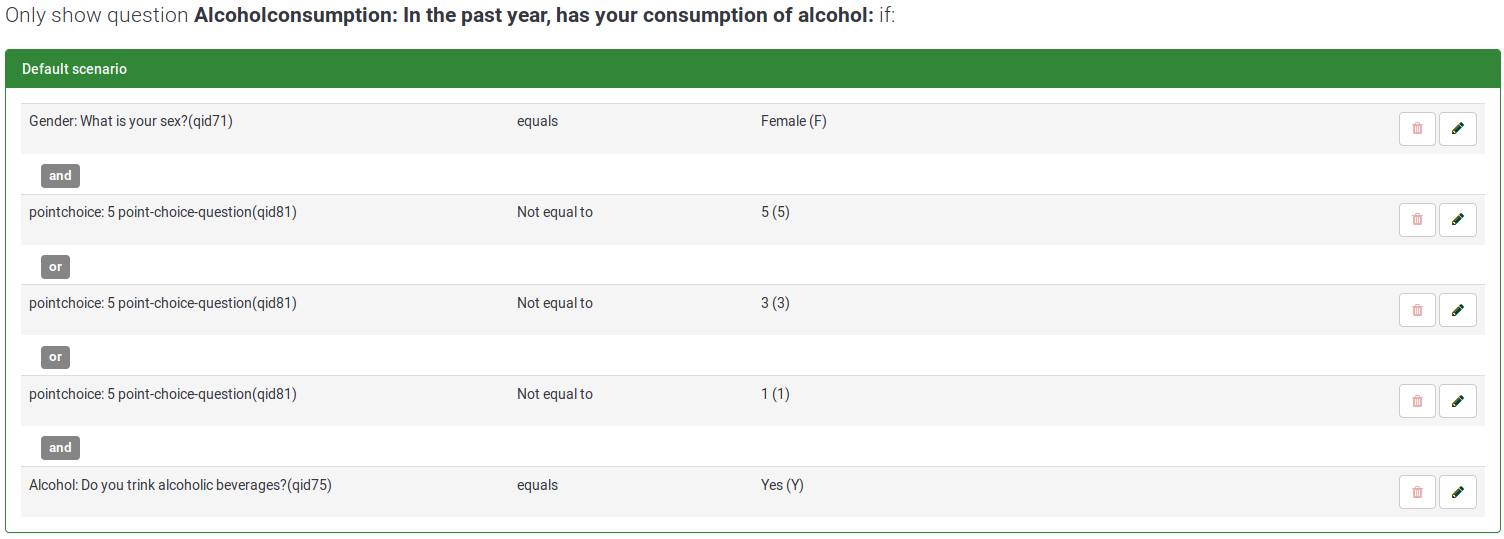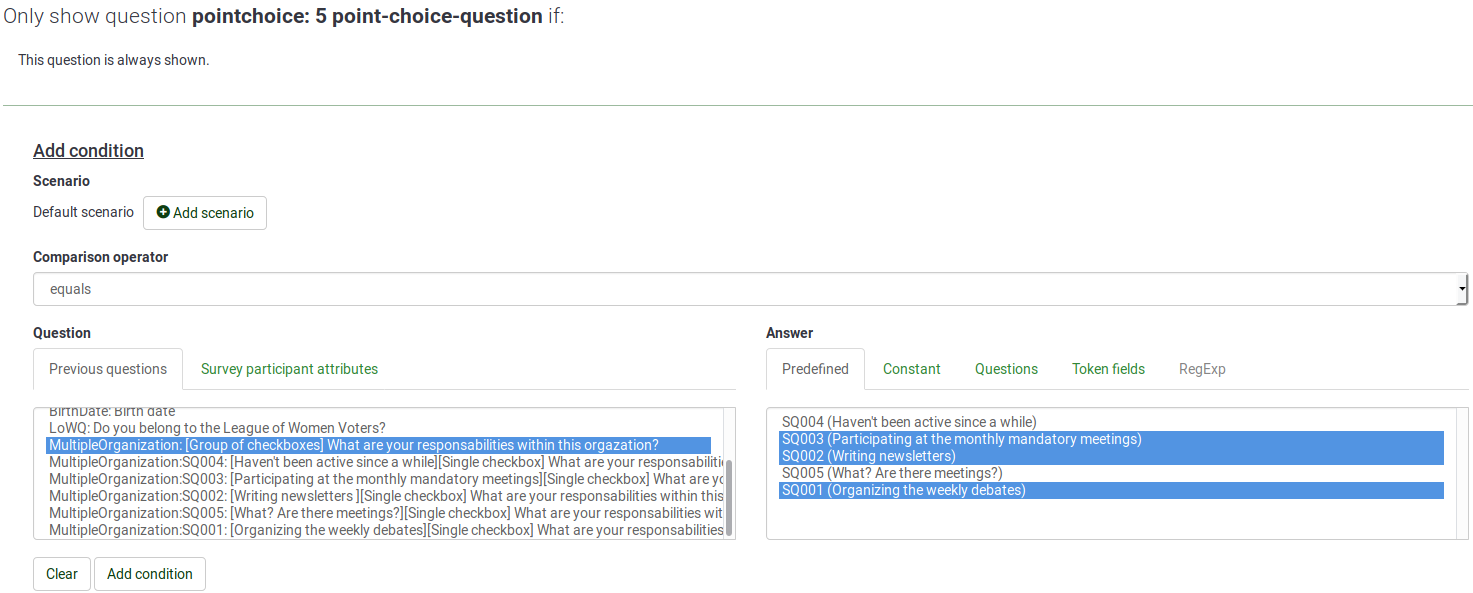Preguntas condicionadas o ramificación
From LimeSurvey Manual
Vistazo a las Condiciones en LimeSurvey
LimeSurvey has a very powerful logical branching feature. It can be accessed by clicking on the Set conditions button - ![]() - located on each question bar.
- located on each question bar.
In this chapter we will describe:
- what conditions you can find in LimeSurvey
- what you can and can't do with conditions
- what steps you need to learn to setup simple or more complex conditions
For step-by-step video instructions check out this tutorial or download the condition sample survey: LimeSurvey_Survey_Setting_Conditions.zip.
Hide/Show Branching Versus Jump Branching
Tú puedes diseñar ramificaciones lógicas con LimeSurvey, esto significa que puedes decidir qué preguntas serán mostradas si y solo si algunas condiciones son cumplidas, de la forma "Mostrar Pregunta X si la Pregunta Y tuvo una respuesta Z".
Our approach is to implement a Hide/Show Branching Logic:
- you can define a condition or a set of conditions on each question of your survey: if the condition is met, the question will be displayed
- a question without a condition defined on it will always be displayed
- a question with a condition defined on it will not be displayed unless the condition is met
This approach is different from the Jump Branching Logic that is sometimes implemented by other software. In the Jump Branching Logic, the resulting action of a met condition would be to jump to another question (that is to say hide all questions in between). LimeSurvey doesn't implement this Jump Branching Logic method. Instead, if you wish to jump a series of questions, you should simply set the same condition on all the questions you do not wish to be displayed. For example, if the jump condition you want to set on Question2 is "Jump to Question5 if the answer to Question1 is 'Yes'", you can simply:
- set a condition on questions 2, 3 and 4 to only display "if the answer to Question1 was NOT 'Yes'"

LimeSurvey makes setting the same condition on multiple questions (and thus implementing Jump Branching Logic) easy by allowing you to "copy" a condition from one question to a series of others. In the above example, you would begin by setting the condition on Question2, then from the same screen you would copy that condition to Question3 and Question4.
Supported Types of Conditions
Basically, a condition can compare values, returning either true or false.
The values that can be compared are answers to previous questions. For instance, If you answered 'Yes' to Question1, you Question2 will then be showed to the survey respondent:

It is important at this point to understand what is considered as an eligible question-entry for the condition editor:
A question-entry is either:
- a simple question (for all question types apart from Array questions)
- for instance: text questions, radio or dropdown lists, and even multiple choices questions
- or a row in Array questions (except for Array dual scale and Array Multiple Flexible questions),
- for instance: Array of 5 radio buttons, array with label questions
- or either the left part or the right part of an Array dual scale question
- or each cell of an Array Flexible question
As a matter of simplification, question-entries are just called "Question" in this document and the condition editor.
- constant values
- for instance: "If you answered more than 18 years to Question2"

- Participant's profile data: To use data from the survey participants table, "Anonymized responses" must be set to NO. This option can be found in survey participant settings tab.

Several comparison operators are supported from the simple "equals", to the advanced "Regular Expression":
- The basic ones are equality, and inequality
- The greater/less than operator family is also available, and is usually only useful when using numeric question-entries
- Please note that comparisons on numeric fields honor the numeric order: for instance 2 < 10
- If you're using a question entry whose type is text, then the condition could be evaluated as "2" > "10" (string order)!
- Numeric questions, as well as text questions (when they have the 'numbers_only' attribute set), will use the numeric order for comparisons
- An advanced comparison operator using regular expressions is also available.
- The "Regular Expression" operator (don't panic: If you don't know what this means, then you don't need it)
- the pattern is not to be enclosed in '/' characters
- for instance: [a-zA-Z]$
How can I combine conditions

You can build complex conditions by combining simple conditions with the AND and OR logical operators.
However, it is important to understand that LimeSurvey automatically determines which logical operator to apply: this means that the use of the OR or AND operators is determined according to the context of the condition.
We'll talk about complex conditions later, but let's start by the simple ones first.
Understanding Simple conditions: elementary conditions
Accessing the editor screen
First you need to access the condition editor:
- open the condition menu by clicking on the conditions icon in the question button bar, when viewing a question.
- then click on the Add and edit conditions icon, the edit conditions screen will appear allowing you to create, edit or delete conditions for the current question.
The following screen will appear:

Note: for the moment don't modify the default scenario (![]() ) that is automatically selected in the condition addition form: we'll discuss this later.
) that is automatically selected in the condition addition form: we'll discuss this later.
Definition of elementary conditions
An elementary condition is simply a single condition without any OR or AND logical operators.
It is composed by:
- a left operand: the tested value
- you can choose the tested value type by selecting the appropriate tab in the condition editor

- a comparison operator
- Choose the comparison operator you want to apply in the dropdown list
- a right operand: the comparison value
- you can choose the comparison value type by selecting the appropriate tab in the condition editor

Example of elementary conditions and how to create them
- Show question IF "the answer to Question1 was the predefined answer 'Male'"
- tested value = answer to Question1
- comparison operator = equals
- comparison value = answer code of the 'Male' answer
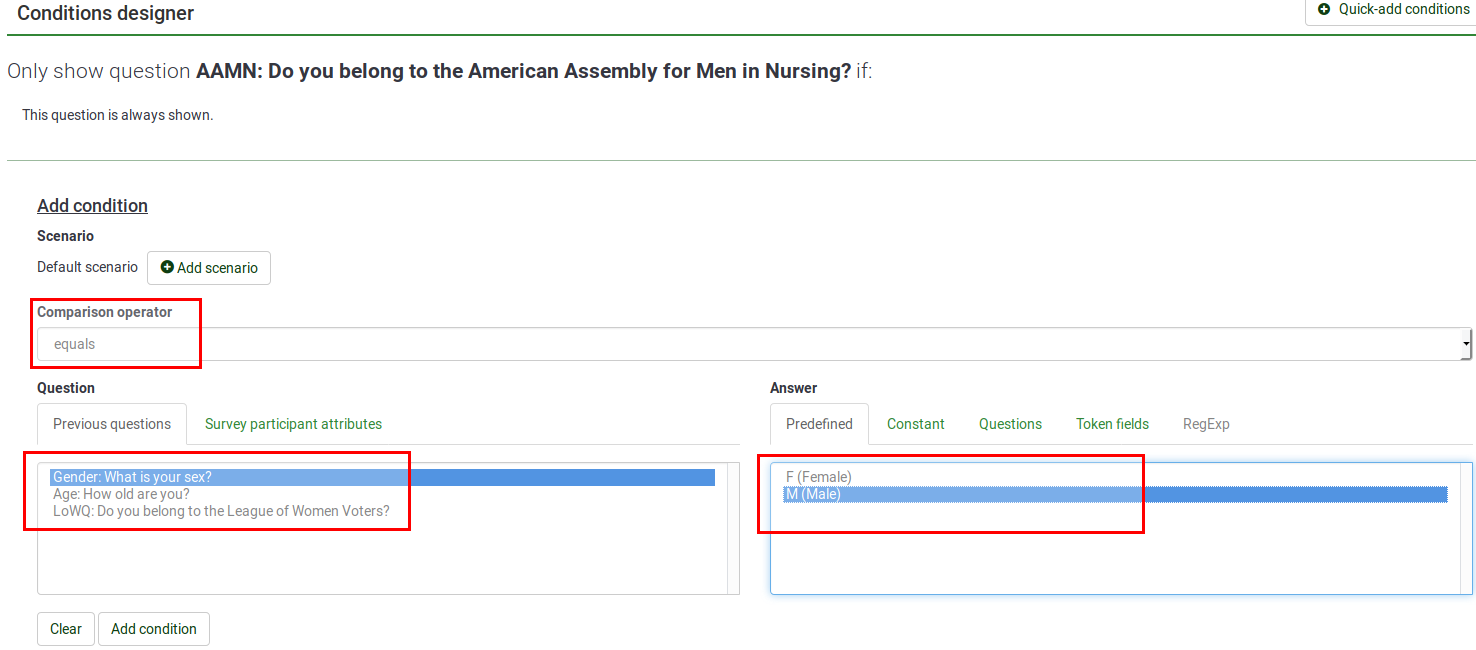
- Show question IF "the answer to Question2 was greater than the numerical value '5'"
- tested value= answer to Question2
- comparison operator= greater than
- comparison value= the constant value 5
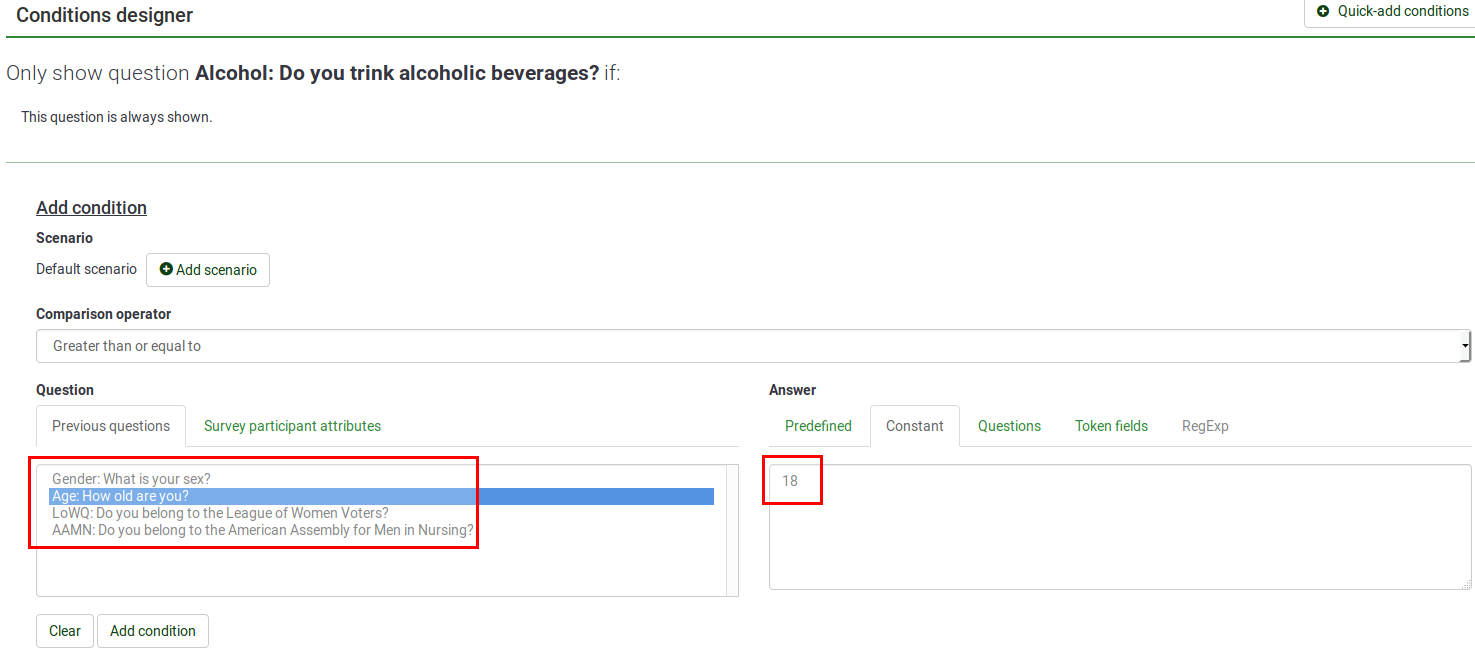
- Show question IF "the answer to Question3 was greater than the answer to Question2"
- tested value= answer to Question3
- comparison operator= greater than
- comparison value= answer to Question2
- Show question IF "the 'Department' value from the participant's profile (Token Attribute from the invitation) equals the 'Accounting' string"
- tested value= the 'Department' value taken from the token invitation
- comparison operator= equals
- comparison value= the constant value 'Accounting'
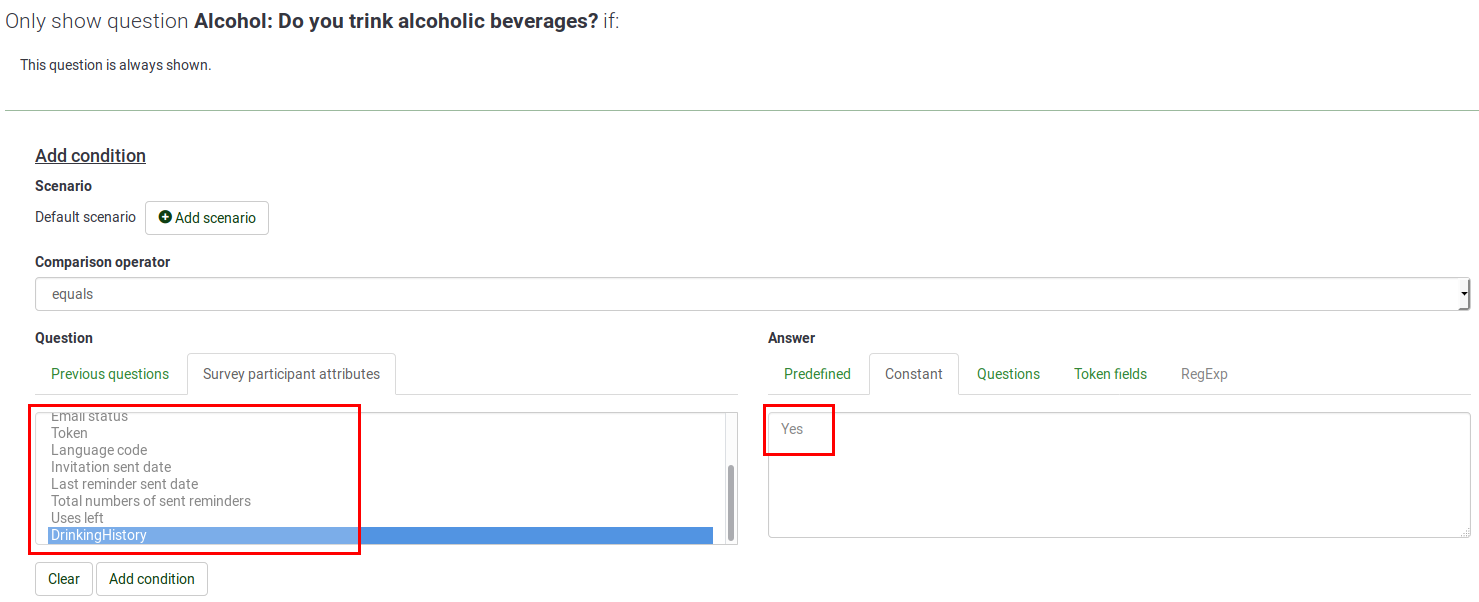
Detailed instructions on how to set up the above example can be found at this blog post: "Conditions based on token attributes"
Default condition combinations
As said earlier, LimeSurvey automatically decides which logical operator (AND or OR) should be applied between conditions depending on the 'context'.
Note also that the order in which you define your elementary conditions is not relevant as LimeSurvey will automatically reorder them according to its own logic.
Let's study this in detail.
First rule: conditions having the same tested value are ORed together
When you have several conditions they are ORed together if they share the same tested value
- this is the case for instance for several possible answers of the same previous question: "If answer to Question1 equals 'green' OR answer to Question1 equals 'red' OR answer to Question1 equals 'blue'"


Second rule: conditions having different tested value are ANDed together
When you have several conditions, they are ANDed together if they don't share the same tested values
- this is the case for instance for several conditions based on different previous questions: "If answer to Question1 equals '4' AND answer to Question2 equals 'green'"
Third rule: ORed elementary conditions take precedence over the other ANDed conditions
Imagine you define the 3 following sets of conditions:
- IF answer to Question "Type !" was 'Green'
- IF answer to question "Type 5" was '4'
- IF answer to question "Type A" was '4' or '5'
- Then the resulting conditions will be:
- Note the capital 'OR' and the lower case 'and': this means that ORed conditions are evaluated as if prioritized with parentheses
- Note also that the order of the elementary conditions creation is not preserved and has no importance here
- The resulting conditions is: IF (answer to question "Type A" was '4' OR answer to question "Type A" was '4') AND (IF answer to question "Type 5" was '4') AND (IF answer to Question "Type !" was 'Green')
The multiple options questions
Note: This paragraph applies to Multiple options and Multiple options with comments questions, and not to Array Multiple Flexible (number) with checkbox layout questions (for this later question type, each checkbox is a separate question-entry and is not really handled as other multiple options question-types).

For Multiple options and Multiple options with comments questions, in the tested valuepart of the condition editor this question will appear in two flavors
- a Group of checkboxes flavor which let you set conditions on all possible answers of this question
- a set of Single checkbox entries which let you set conditions on each checkbox individually
And now let's test your knowledge of conditions by trying to answer this question:
- I've got a multiple options question:
- Issue A: How can I set ORed conditions between different answers of this question
- Issue B: How can I set ANDed conditions between different answers of this question
...
...
...
Now the answers...
For Issue A:
- Use the Group of checkboxes entry as your tested value and select as much answers you want
For Issue B:
- Use the Single checkbox entry that correspond to the first answer you need to set the condition on and set the condition to the checked comparison value
- Use the Single checkbox entry that correspond to the second answer you need to set the condition on and set the condition to the checked comparison value
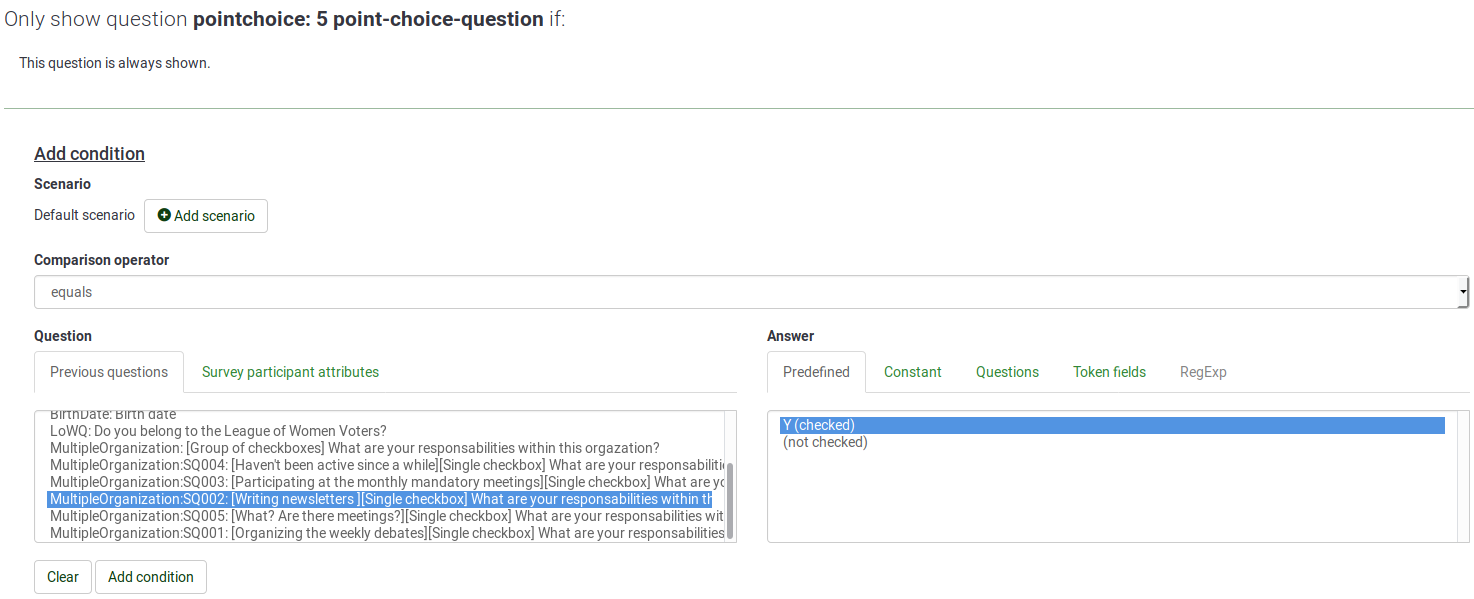
- Enjoy the result:

Using ORed conditions between different questions: the use of scenario
Now, you may argue that sometimes you need to have ORed conditions even when they are set on different questions (that is to say on different tested values): this is where scenarios can be used.
Definition of a scenario
A scenario is simply a manual grouping of conditions in which conditions are evaluated independently of conditions from other scenarios. The complex condition resulting in this association of several scenarios will be met if only one scenario is met: in other words scenarios are logical grouping of conditions, respecting the above rules, and which are ORed together to build complex conditions.
All what we described above is true inside a scenario, and by default all new conditions are created inside the "Default Scenario".
However, when you create a new elementary condition, you decide to affect it to another scenario than the default one.
Scenarios are identified by a simple number, the "Default scenario" having number '1' as its identifier.
Adding a question to another scenario
When you create (or edit) a condition, you can modify the scenario in which the condition is stored:
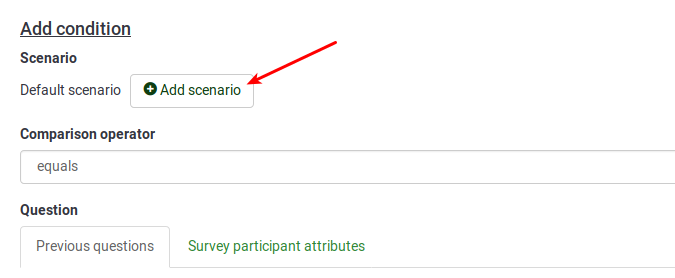
If you need to define a condition in another scenario than the default one, click the new scenario icon File:Plus.png, and type in the scenario number: File:Default scenario edit.png
The number id of a scenario has no importance and different scenarios can have non-continuous ids.

Using the editor
Editor overview
First you access the condition editor:
- open the condition menu by clicking on the conditions icon in the question button bar, when viewing a question.
The top part of the window always shows any conditions already set for this question:
In the example above question B is set to only display if:
- The answer to the question-entry FBI of previous question A is "1"
- AND
- EITHER the answer to the question-entry CIA of previous question A is "5"
- OR the answer to the question-entry CIA of previous question A is "3"
In Add/Edit mode File:Conditions add.png, some specific actions are possible on each line such as:
- edit condition

- delete all conditions
 , delete this condition
, delete this condition  , delete all conditions from this scenario
, delete all conditions from this scenario 
- edit scenario

In Copy mode ![]() , each line is prepended with a checkbox allowing you to select those conditions you want to copy to later questions:
, each line is prepended with a checkbox allowing you to select those conditions you want to copy to later questions:
Setting new conditions
First select the scenario
If you don't need ORed conditions between different question-entries, just don't modify the default scenario (![]() ) that is automatically selected in the condition edition form.
) that is automatically selected in the condition edition form.
On the contrary, if you need to define a condition in another scenario than the default one, click the new scenario icon File:Plus.png, and type in the scenario number: File:Default scenario edit.png
The number id of a scenario has no importance and different scenarios can have non-continuous ids.
Select the tested value
Click on the tab corresponding to the type of the tested value you want: it is either a previous question or a value taken from the profile of the participant (token attribute).
Note that in order to use the Token your survey must:
- not use anonymous answers
- use a token table and closed access
Then select the entry you want as tested value.
If you select a question-entry (from the 'Previous questions' tab) and if this question uses predefined answers then the corresponding predefined answers are displayed in the Predefined tab of the comparison value selection.
Select the comparison operator
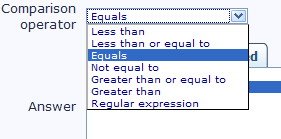
Several comparison operators can be used:
- The basic ones are equality, and inequality
- The greater/less than operator family is also available, and is usually only useful when using numeric question-entries
- Please note that comparisons on numeric fields honor the numeric order: for instance 2 < 10
- If you're using a question entry whose type is text, then the condition could be evaluated as "2" > "10" (string order).
- Numeric questions, as well as text questions having the 'numbers_only' attribute set, will use the numeric order for comparisons
- An advanced comparison operator using regular expressions is also available. When selected, the answer input box will automatically switch to the advanced mode.
Selecting an comparison value
Select the tab that corresponds to the type of comparison value you need: it can be a predefined answers, a constant value, an answer from a previous question, a value from a token attribute, or a regular expression (reserved for the advanced regular expression operator).
Then select or type in the value you want to use.
Note that if you select a value in a tab, then change the tab and select another value in this other tab, the first option you selected is lost.
When using predefined answers, you can then select one or more predefined answers:
- the possible answers for that question
- Choose the answer that you want to use
- You can choose multiple answers in one go by using the CTRL button and clicking on more than one answer in the right hand select list
After that click on the "Add Condition" button.
Editing/Deleting conditions
Apart from adding new conditions, the Add/Edit can be used to
- edit conditions
- delete conditions
- edit scenario
Edit conditions
By clicking on the edit icon ![]() on a condition line, the edit condition form at the bottom is automatically displayed with the current settings for this condition. Note that in this mode you can only select one predefined answer.
on a condition line, the edit condition form at the bottom is automatically displayed with the current settings for this condition. Note that in this mode you can only select one predefined answer.
Click the update condition button to update this condition.
Delete conditions
You can:
- delete a single condition by clicking on this icon

- delete all conditions within a scenario by clicking on this icon

- delete all conditions from this question by clicking on this icon

Edit Scenario
You can change the number assigned to a scenario by clicking this Icon ![]() and fill-in the form that appears on the same line.
and fill-in the form that appears on the same line.
Alternatively, you can renumber scenarios by clicking on this icon ![]() .
.
As said above, scenario numbers have no impact in the way conditions are evaluated. However, modifying the scenario numbers are needed in order to:
- decide in which order the scenario are displayed when using the printable version of a survey
- merge conditions from 2 scenarios (in order to merge scenario 10 to scenario 1, just renumber scenario 10 with scenario id 1).
Copying conditions to later questions
It is not uncommon for a group of questions to have the same condition. Luckily you can copy this condition to any subsequent question from the conditions designer once a first condition has been set.
Switch to the copy mode by clicking the on the Copy conditions icon ![]() .
.
File:Copy conditions example.png
The conditions applying to the current questions are displayed with a checkbox on their left. You can:
- select each condition individually by checking the checkbox on the left of the condition
- or select all conditions from a scenario at a time by checking the checkbox on the left of the scenario
Then select all subsequent questions in the survey on which you want to copy the selected conditions from the bottom Select box by highlighting them (using the CTRL key to select multiples). Then click on the "Copy Conditions" button to copy them across.
It is usually best to leave this until you have finished entering all your survey questions, and are satisfied with the question order.
Things to watch out for
General considerations
There are a few basic rules you should keep in mind before setting conditions on a question:
- Once a single condition has been set for a question, that question will not display unless that condition is met.
- Conditions can only be set based on questions that appear before the question on which the condition is set.
- If you change the order of questions in your survey after you create conditions LimeSurvey does not warn you if the changed order will break a condition. You should always leave the creation of conditions until you are satisifed with the order of questions and groups in your survey.
- You can modify conditions even after a survey has been activated. This should be done with caution, as there is no "consistency checking" applied here.
Conditions using the 'no answer' predefined answer

Setting the following condition "Show question Q20 if answer to question Q1 is 'no answer'" really means "show question Q20 if question Q1 was displayed and received no answer". This is not equivalent to "show question Q20 if question Q1 was not displayed"
Chained conditions
If you set conditions on a question that, itself, has conditions, then there may arise occasions where the survey behaves in ways you might not have predicted. For example a typical side-effect is that if you hide all questions in a group with chained conditions that the group header will still be shown unless you correct these conditions as explained below.


In the example above a question is displayed 'Do you like being male?' which has conditions set, and which will only display if the answer to What is your gender? is M. If you were to add a condition to this question requiring a specific answer from the Do you like being male? question, then this question will never display, because the question Do you like being male will not be presented.
It is highly recommended that you copy the conditions from the earlier question to the one you're editting.
For instance, you want the following:
- Q1 is a Gender question
- Q2 is a Yes/No and is displayed if answer to Q1 is Male
- Q3 is a ranking question and is displayed if Q2 is Yes
What you really need to setup is the following set of conditions:
- on Q2: display question if answer to Q1 is Male
- on Q3: display question if answer to Q1 is Male AND answer to Q2 is Yes
After correction, the correct set of conditions for Q3 should look like:

So if you are designing a complicated survey with large number of conditions, make sure you test the survey for as many different combinations of results as you can think of.
Limitations and workarounds
Progress-bar
If you create a survey where many questions get skipped because of conditions, the progress bar will jump a big step forward, or the survey ends at 50%.
To avoid such behavior, the questions that could be skipped, should be arranged between the shown questions, so that only one or two questions get skipped per answer.
For Example: based on question one (yes or no question) 14 questions will be asked question 2A to 15A when the answer of question one was yes, 2B to 15B when the answer to question one was no.
If you arrange the questions in one group and arrange them like: 2A, 2B, 3A, 3B, and so on you will get a nearly correct progress bar, while arranging the questions like 2A, 3A, 4A, [...], 2B, 3B, 4B, ... you will get a progress bar from 0 to 50% or from 50% to 100%, depending on the answer to the first question.
Setting a constant comparison value for a "Date" Question Type
You have to use the internal representation of Date values, which is YYYY-MM-DD to define your constant comparison value.
Setting conditions for "Other" Options in the Multiple Options Question Type
In the multiple options question type, you can use the "Other" provided in the question type as a valid choice but you cannot set conditions on it. For example: Question No 1 says "Which color do your prefer to use?" Answer checkbox choices are Blue, Black and Other. If the participant chooses Blue, you can set a condition. If the participant chooses Black, you can set a different condition. However, if the participant chooses "Other" and types in something in the text box, there is NO way a condition can be set. LimeSurvey does not recognize if the participant chose the "Other" condition. This is NOT a bug but a limitation.
There is no real field recorded for the 'other' checkbox for this question type. Thus, the only way to know if the user has answered the 'other' part of the question or not would be to check if the value of the text written in the other input field is empty or not.
However, due to the specific way we handle Multiple choice questions, testing the 'other' text input field has never been implemented.
As a workaround, add an explicit answer option called 'Other' and do not use the built-in 'other' option of these question types. Then add an additional short text question which will be displayed if this 'Other' checkbox was clicked.
How to use parenthesis for the boolean expressions?
You can't!
If you want to design something like:
(condition1 OR condition2) AND (condition3 OR condition4)
you'll have to set up:
(condition1 AND condition3) OR
(condition1 AND condition4) OR
(condition2 AND condition3) OR
(condition2 AND condition4)




